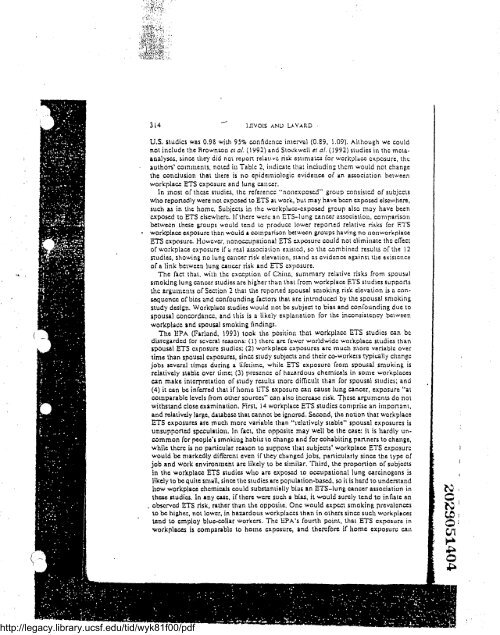ets exposure, lung cancer - Legacy Tobacco Documents Library
ets exposure, lung cancer - Legacy Tobacco Documents Library
ets exposure, lung cancer - Legacy Tobacco Documents Library
You also want an ePaper? Increase the reach of your titles
YUMPU automatically turns print PDFs into web optimized ePapers that Google loves.
http://legacy.library.ucsf.edu/tid/wyk81f00/pdf<br />
314 ~ lrvots nrdu 1AYAnn<br />
U .S. studies was 0 .98 with 95''ro confidencc interval (0 .89, 1 .09) . Although we could<br />
not include the Arownsou ci al . (1992) and Stockwcil rr al . (1992) studies in the mctaanalyscs,<br />
since they did not report relative risk esumatrs for workplacc <strong>exposure</strong>, the<br />
authors' cotnutents, noted iu Tablc 2, indicate tha : including them would not change<br />
the conclusion that there is no epidetniologic evidence of an association between<br />
workplace ETS <strong>exposure</strong> and <strong>lung</strong> catlcer .<br />
In most of these studies, the referencc "nonexposed" group consisted of subjects<br />
who reportedly were not exposed to ETS at work, but may have b .:ccn czposed clsrwhere,<br />
such as in the homc . Subjects in the workplacc•cxposed group also may have been<br />
exposed to ETS elsewluru. 1f there werc an GTS-Jung eancer association, camParison<br />
betwecn these groups would tcnd to produce lower reported relative risks for F."15<br />
• workplace exposurc than would a comparison between groups having no natworkplace<br />
ETS <strong>exposure</strong>. Howcver, ttonoccuPational ETS <strong>exposure</strong> could not climittate the cffect<br />
of workplace <strong>exposure</strong> if a real association existed, so tlu combined results of the 12<br />
studies, showing no <strong>lung</strong> <strong>cancer</strong> risk elevation, stand as cvidcnce against tlte existence<br />
of a link between <strong>lung</strong> cattcer risk and E7S <strong>exposure</strong> .<br />
The fact that, with the cxccption of Chiua, summary relative risks from spousal<br />
stnoking <strong>lung</strong> <strong>cancer</strong> studies are higher than that from -orkplace ETS studies suppoRs<br />
the arguments of Section 2 that tlu rcponed spousal smoking risk elevation is a con•<br />
sequcnce of bins and confounding factors that are introduced by the spousal smoking<br />
study design . Workplace studies would not be subjeet to bias and confounding due to<br />
spousal concordance, and this is a likely explanation for the inconsistency between<br />
workplace and spousal smoking findings .<br />
The EPA (Farland, 1993) took the position that workplacc L•TS studies ean be<br />
disregarded for several reasons: (1) thcre arc fewer worldwidc workplace studies than<br />
spousal ETS <strong>exposure</strong> studies ; (2) workplaco <strong>exposure</strong>s arc much more variable over<br />
time than spousal cxposures, sinee study subjects and their co-wurkers typic :ally changc<br />
jobs severnl times during a lifetime, while ETS <strong>exposure</strong> fratU spousal smoking is<br />
relatively stable over time ; (3) presence of ha :e.ardous chemicals in somc workplaces<br />
can make interpretation of study results lnorc difficult than for spousal studics ; and<br />
(4) it can be inferred that if home b?S <strong>exposure</strong> can cause <strong>lung</strong> <strong>cancer</strong>, <strong>exposure</strong> "at<br />
comparable levels from other sources" can also incrcasc risk . These arguments do not<br />
withstand close examination . Iirst, 14 workplace E'i'S studies comprise an important,<br />
and relatively large, database that cannot be ignored . Second, the notion that workplace<br />
rTS <strong>exposure</strong>s are much more variable than "relativcly stable" spousal <strong>exposure</strong>s is<br />
unsupported spcculatiotl, In fact, the opposite may well be the case : it is hardly uncommon<br />
for people's smokius habits to change and for cohabiting partners to change,<br />
while there is no particular reason to suppose that subjects' workplace ETS <strong>exposure</strong><br />
would be markedly difCerent even if they changed jobs, particularly since the type of<br />
job and work environtnent are likely to be similar . Third, the proportion of subjccu<br />
in the workplace ETS studies who arc exposed to occupational <strong>lung</strong> carcinogens is<br />
likely to bc quite small, since 111c studies arc population-bascd, so it is hard to understand<br />
how workplaae ehcmicals could substantially bias an ETS-<strong>lung</strong> <strong>cancer</strong> association in<br />
these studics. In any case, if there wcrz such a bias, it %++ould surely tend to inflate an<br />
observed ETS risk, rather than tlu opposite . One would expcct smoking prevalences<br />
to be higher, not lower, in hazardous workplaces than in others since such vvorkplaces<br />
tend to employ bluc.collar workers . The I:PA's fourth point, that ETS <strong>exposure</strong> in<br />
workplaces is comparable to home <strong>exposure</strong>, and therefore if home exposurc can<br />
I<br />
I

















